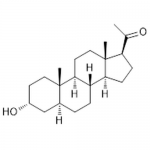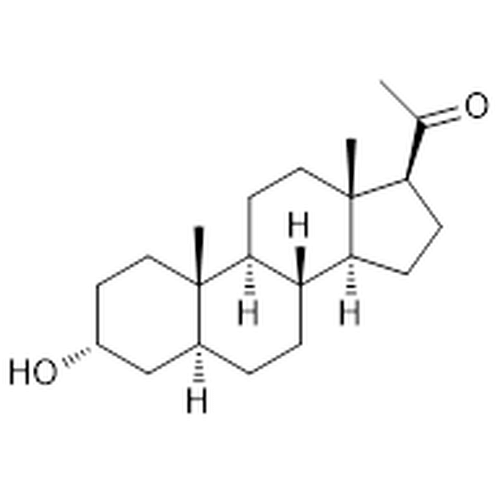| Product Name | Allopregnanolone |
| Description |
Positive allosteric modulator of GABAA receptors |
| Purity | >98% (HPLC); NMR (conforms) |
| CAS No. | 516-54-1 |
| Molecular Formula | C21H34O2 |
| Molecular Weight | 318.5 |
| Field of Use | Not for use in humans. Not for use in diagnostics or therapeutics. For in vitro research use only. |
Properties
| Storage Temperature | -20ºC |
| Shipping Temperature | Shipped Ambient |
| Product Type | Inhibitor |
| Solubility | May be dissolved in DMSO (32 mg/ml); or Ethanol (32 mg/ml) |
| Source | Synthetic |
| Appearance | White to off-white powder |
| SMILES | CC(=O)C1CCC2C1(CCC3C2CCC4C3(CCC(C4)O)C)C |
| InChI | InChI=1S/C21H34O2/c1-13(22)17-6-7-18-16-5-4-14-12-15(23)8-10-20(14,2)19(16)9-11-21(17,18)3/h14-19,23H,4-12H2,1-3H3/t14-,15+,16-,17+,18-,19-,20-,21+/m0/s1 |
| InChIKey | AURFZBICLPNKBZ-SYBPFIFISA-N |
| Safety Phrases |
Classification: Not a hazardous substance or mixture. Safety Phrases: S22 - Do not breathe dust. S24/25 - Avoid contact with skin and eyes. S36/37/39 - Wear suitable protective clothing, gloves and eye/face protection. |
| Cite This Product | Allopregnanolone (StressMarq Biosciences Inc., Victoria BC CANADA, Catalog # SIH-582) |
Biological Description
| Alternative Names | (3α,5α)-3-Hydroxy-pregnan-20-one; (3α,5α)-tetrahydroprogesterone; 3-OH-DHP |
| Research Areas | Cell Signaling, Neuroscience |
| PubChem ID | 92786 |
| Scientific Background |
Allopregnanolone is a naturally occurring neuroactive steroid derived from progesterone, notable for its potent modulatory effects on the central nervous system. Unlike its parent hormone, Allopregnanolone lacks progestational activity and instead functions as a positive allosteric modulator of GABA_A receptors—the primary inhibitory neurotransmitter system in the brain. Through this mechanism, it enhances GABAergic signaling, promoting anxiolytic, sedative, and neuroprotective effects. In neurodegenerative disease research, Allopregnanolone has emerged as a promising therapeutic candidate due to its ability to support neuronal survival, reduce neuroinflammation, and promote neurogenesis. It has demonstrated efficacy in preclinical models of Alzheimer’s disease by reversing cognitive deficits, reducing amyloid pathology, and stimulating the proliferation of neural progenitor cells in the hippocampus. These effects are particularly significant given the loss of neurogenesis and synaptic integrity observed in aging and neurodegeneration. Allopregnanolone’s clinical relevance was further underscored by its FDA approval for the treatment of postpartum depression, highlighting its safety and efficacy in modulating mood and brain function. Its multifaceted actions on neural circuits, stress response systems, and cellular resilience make it a compelling molecule for ongoing research into neurodegenerative disorders, including Alzheimer’s, Parkinson’s, and Huntington’s diseases. |



Reviews
There are no reviews yet.